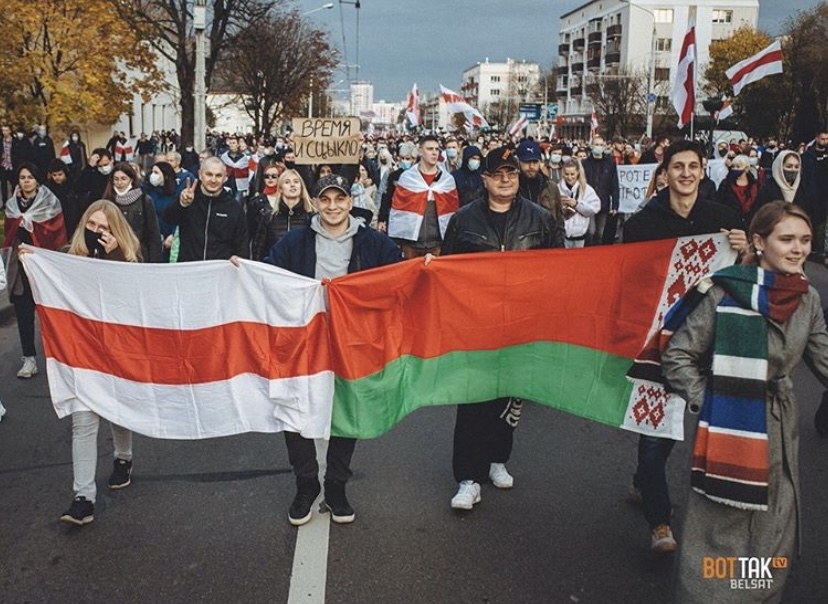For most, 2020 has been a grim and depressing year for many. With COVID-19 in the air, gender reveal parties gone awry, and the crisis in Yemen, things have not looked bright for this year. However, the situation in Belarus has at least given a glimmer of hope left in 2020.
For those unfamiliar, nationwide protests throughout the country of Belarus were sparked after Belarusian head of state (and current disputed leader of Belarus) Alexander Lukashenko won his sixth term in office as President of Belarus in the 2020 Belarusian elections. The election results have been contested by Lukashenko’s opponent, Svetlana Tikhanovskaya, and the protests have been occuring since August 9th, 2020.
However, this isn’t why we’re here. We’re, of course, talking about the significance of the flags used throughout the protests. The flags that have represented both sides of the aisle in Belarusian politics. They are of course the white-red-white flag of pre-1994 Belarus and the current flag of Belarus (used by the Belarusian opposition and supporters of the current government respectively).
So let’s cover both of these flags and why they’re important in their symbolism, shall we?
“The White-Red-White Flag” (“Бел-чырвона-белы сцяг”); Used from 1918-presnt (Belarusian Democratic Republic and its government-in-exile) and 1991-1995 as the Republic of Belarus

The White-Red-White flag of Belarus is a very significant flag in Belarusian culture, as it is used as a symbol (such as the flags being used in protests, umbrellas used with the colors of this flag, as well as clothes sometimes worn in the same pattern as the flag). But why is this flag in particular used by the Belarusian opposition (such as the Belarusian Left Party, a socialist party in Belarus opposed to Lukashenko, and leaders within the Belarusian Coordination Council led by Belarusian presidential candidate and disputed President-elect of Belarus, Svetlana Tikhanovskaya)?
The answer would lead to the formation of the Belarusian Democratic Rada in 1918 with Jan Sierada taking the role of the Chairman of the Rada of the Belarusian Democratic Republic. The flag that would be used by the Belarusian Democratic Republic is believed to be designed by Klawdziy Duzh-Dushewski, a Belarusian civil engineer, diplomat, and journalist. The Belarusian Democratic Republic was declared in a German-occupied territory that makes up the area of modern day Belarus.

However, this provisional nation did not last long, as the German Army retreated from Belarus in December 1918. This allowed for the Red Army, led by Leon Trotsky as the People’s Commissar of Military and Naval Affairs of the Soviet Union, to invade Belarus and declare the Socialist Soviet Republic of Belarus (a predecessor to the similar sounding “Byelorussian Soviet Socialist Republic”).
The declaration of this proto-Soviet Socialist Republic (that would eventually make up the USSR in 1922) forced the Rada of the Belarusian Democratic Republic out of power in Minsk, thus moving the capital to Grodno. However, this would (again) prove to be short-lived as the 1919-1920 Polish-Soviet War forced the Rada of the Belarusian Democratic Republic to then leave Belarus permanently in 1920 after the Byelorussian Soviet Socialist Republic was declared by Soviet authorities after the conclusion of the Polish-Soviet War.
This then caused the Rada of the Belarusian Democratic Republic to declare a capital-in-exile for the time being. From 1920 to now, the Belarusian Democratic Republic’s capital-in-exile has been in Kaunas (from 1919-1923), Prague (1923-1945), Paris (1948-1970), Toronto (1970-1983), and Ottawa (1983-Present).
Today, the Rada of the Belarusian Democratic Republic acts as a lobbying interest group for the nations that represent the Belarusian diaspora across the world (such as Canada and the United States).
While the Belarusian Democratic Republic is the most known example of the White-Red-White flag being used by a nation/nation-in-exile, the flag has been used in lesser known (and in some cases, unofficial) circumstances.
For example, the flag was flown unofficially in West Belarus until 1938 (which, at the time, was apart of the Second Polish Republic). The flag was used by supporters of the Belarusian national movement in Poland both by political organizations like the Belarusian Peasants’ and Workers’ Union or the Belarusian Christian Democracy, and non-political organizations like the Belarusian Schools Society.

The flag has also had unofficial use with the Byelorussian Central Rada, a collaborationist government established within the Generalbezirk Weißruthenien (itself apart of the Reichskommissariat Ostland) established as a piece of the plan to expand Germany’s borders through Lebensraum. The flag (as well as a modified version of Belarus’s coat of arms, the Pahonia) was used as an approved national symbol for the collaborationist government. It was also used as an identification patch for Belarusian conscripts within the Heer, as well as volunteer units within the Waffen SS and the Byelorussian Home Defense.
The White-Red-White flag of Belarus also had its use in the newly established Republic of Belarus in 1991 when the Byelorussian Soviet Socialist Republic declared independence from the Soviet Union in 1990. However, the use of this flag was brief as the flag was abandoned by the Belarusian government in 1995 after President Alexander Lukashenko came to power in the 1994 presidential election (the first election since the country gained independence from the Soviet Union in 1991). The flag was then replaced with the flag that is a modification of the flag of the Byelorussian Soviet Socialist Republic that was used from 1951-1991.
So…why does the Belarusian opposition use this flag as well as any symbolic use in its colors? It’s simple: the flag represents a time when Belarus was not ruled by Lukashenko (who was/is seen as a very unpopular in Belarusian politics due to his human rights abuses and controversial comments).
The Soviet-looking Flag: The Flag of Belarus used from 1995-Present in both official use and supporters of the current Lukashenko administration
So what’s with the current flag of Belarus then? As of writing this article, it is the current flag of the Republic of Belarus since 1995 (with minor adjustments made to the flag in 2012) and is used by the opposite side of the 2020 Belarusian protests that support the disputed head of state of the Republic of Belarus. Let’s dive into the history of this flag and why it is used by not only supporters of Alexander Lukashenko but also the current government of Belarus since 1995.
Officially, the flag was adopted June 7th, 1995 after a referendum was made on the flag on April 11th, 1995 that placed the new flag into existence. However, the flag has obvious roots dating back to the days of the Soviet Union and its past in late Stalinism.
The predecessor to Belarus’s flag prior to 1995 (and 1991) was the flag of the Byelorussian Soviet Socialist Republic that was adopted in 1951 and relinquished in 1991 after the dissolution of the USSR on December 25th, 1991.

The designer of both Belarus’s current flag and the flag of the Byelorussian SSR was Mikhail Gusyev, The flag was adopted on December 25th, 1951 by the Byelorussian SSR’s Supreme Soviet (the main legislative institution of a SSR in the Soviet Union). The flag was created due to a need of a distinct flag for the region of Byelorussia (as the flag of the BSSR was a modified version of the flag of the USSR that included the letters “BSSR” in Cyrillic underneath).
The most notable detail about this flag is the distinct pattern on the hoist of the flag. The embroidery pattern came from the ruchnik (handtowel) design that was known from traditional Belarusian handtowels and embroidered carpets (in the same vein as how the Turkmenistan flag of today shares this quality).
Symbolically, the design on the BSSR flag is decoded as follows (considering design strip positioned horizontally):
- the central rhombus figure symbolises the rising Sun;
- the horn-like figures to the left and right of it symbolise wealth and welfare;
- the figure inside of the rhombus is the “key to happiness”;
- the rectangular figure with the smaller rectangles adjoining from the left and right is the “votive sign”, expressing the desire for fulfillment of hopes;
- the pattern figure symbolises bread (it was absent from the original embroidery, added after some discussion).
The flag was relinquished after the dissolution of the Soviet Union by General Secretary of the Communist Party of the Soviet Union and 1st President of the Soviet Union Mikhail Gorbachev.
However, this flag was brought back in 1995 through the referendum that was endorsed by President of Belarus Alexander Lukashenko. The opposition, at the time, questioned if such a referendum was even legal at all as according to the 1995 Law on national referendums (Закон аб усенародным галасаванні (рэферэндуме)), the national symbols and official language were not allowed to be questioned on a referendum at all;
- Formalities of approval of the referendum by the Parliament have not been carried out;
- The opposition had limited access to media, observers from the opposition have reported fraud in vote counts.
Regardless of outcries from the opposition, the referendum passed, with the proposed modified flag of the Byelorussian SSR making a return in 1995. The main difference between this flag and the flag of the Byelorussian SSR is the removal of the hammer and sickle from the flag entirely (this was to, of course, symbolize that Belarus has not been a Marxist-Leninist one party state since 1991).
So why is this flag used at all? The reason is the same with why Transnistrians still use the flag of the Moldavian Soviet Socialist Republic as their main flag to use in foreign and domestic affairs: Neo-Sovietism and nostalgia for the Soviet Union. For many born before 1991, the Soviet Union is seen positively by those who grew up in the country prior to the collapse of the nation (especially by those of the Khrushchev and Brezhnev Generations of vatniks). As a result, the use of this flag was to garner support for Lukashenko as a leader who wishes to “bring back the nostalgia of the USSR” and protect that generation.
Conclusion
While the protests in Belarus are tragic, it has at least provided both myself and those that are reading this article to educate themselves of the vexilogical and political history of Belarus’s rival flags. Hopefully, these protests do come to a close peacefully and that a solution is made in the nation.
AUTHOR’S NOTE: I would like to add that despite the unofficial uses by collaborationist forces and Nazi Germany, this does NOT make the White-Red-White flag of Belarus a “white supremacist symbol” or a symbol promoting Neo-Nazism. Other collaborationist forces during World War II such as the Ukrainian Liberation Army, the Russian Liberation Movement, the Lokot Autonomy, the Rusian Protective Corps, the First Russian National Army, and paramilitary forces such as the Arrow Cross of Hungary and Iron Guard of Romania incorporated their national flags into these military units loyal to Nazi Germany and fascist paramilitaries in their respective nations. It is the same way that Neo-Nazis will sometimes use either the national flag of their respective nation (or a modified version of it) to use a national symbol for their disgusting agenda.
TL;DR The White-Red-White flag of Belarus is a flag representing the Belarusian democratic opposition wishing to see free elections and an end to human rights abuses in Belarus, not Neo-Nazis and white supremacists. Fun With Vexillology does not condone bigotry of any kind.

